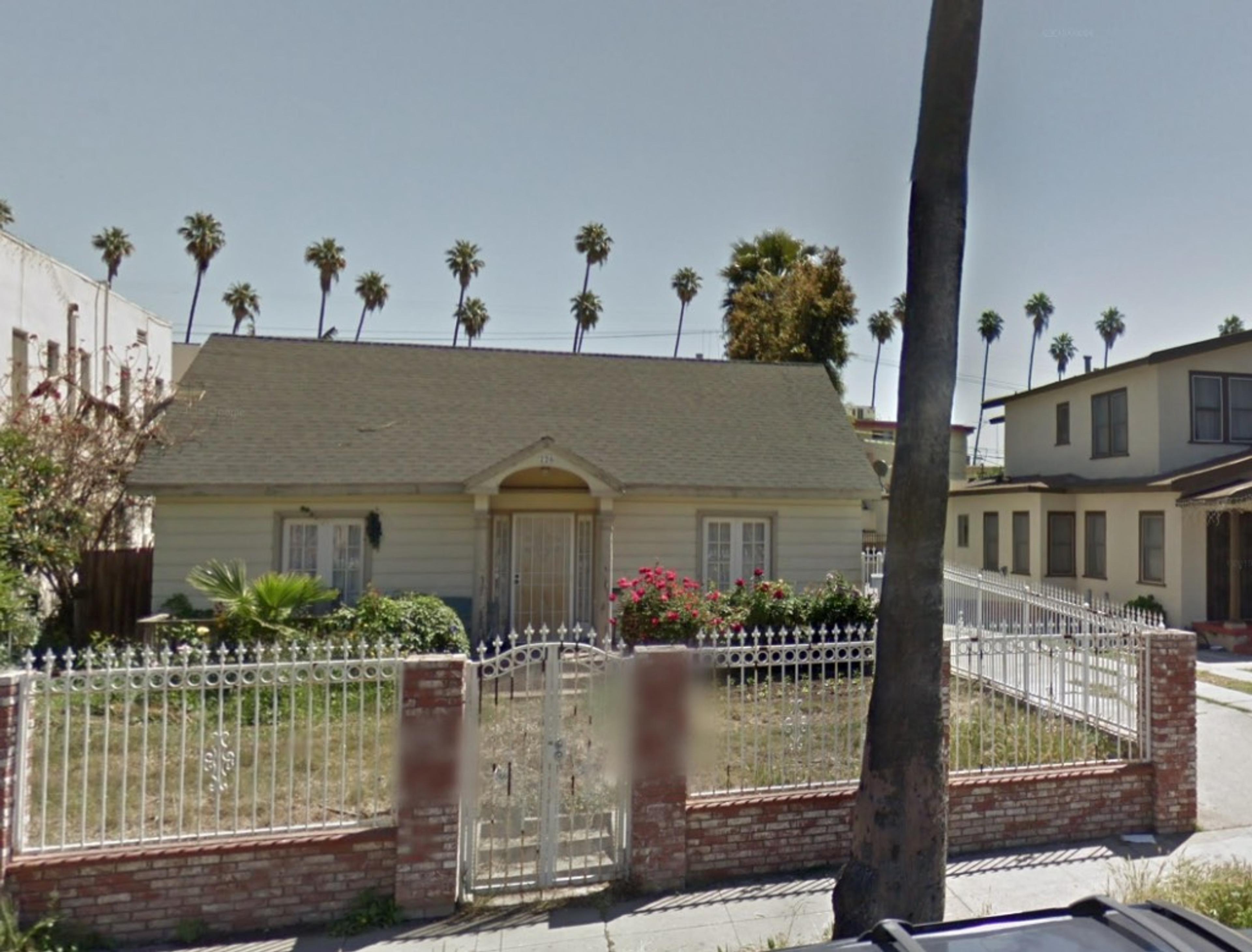My Lord, who stuccos a house anymore? Seriously, I thought that nonsense disappeared years ago, like kids selling crack or approaching you to replace your pea stone with tar macadam.
So here is 226 North Berendo a few years ago, looking like she needs a paint job, but a lovely little house nonetheless. Nice horizontal board. I especially like the two sets of French doors opening onto the yard.
And she _gets_ a paint job!
226 had been built by Dr. M. E. Hutchinson, who acted as his own architect, in 1919.
But then the Stuccoman comes a-callin’ and turns those French doors into two vinyl sliders. And suffocates the house in that putty-colored horror.
Hey, they kept the columned entryway and the sidelights!
Here’s my theory. The reason they stuccoed the poor house is so that I’d be less annoyed when they surrounded it in demo fencing. It didn’t work. Pro tip: I don’t get _less_ annoyed very easily.
You knew this was coming:
Yep, no open space, built to edges of the lot, taller than it’s allowed to be, no parking, with an 80% density bonus and 55% increase in floor area ratio.
Let’s take a look at the neighborhood, because I like to give these things some context.
Beverly at left, Council Street right. Our little house dead center with the dark green lawn.
This is what they’re building on that little lot smack in the middle of the block. YIMBYs always say “but we only build wildly overscaled things on corners! On commercial streets!”
Looking up from Council Street toward Beverly. 226 about dead-center on the block. So all these little houses with their front lawns are going to have a new Imperious Master. Up at the corner at Beverly we have the 1926 Dicksboro Apartments (Richard D. King - Villa Riviera, Redwine, Sparkletts , etc. etc.) and I love the Dicksboro more than anything, but its size belongs rightly on Beverly, not halfway down the block on Berendo.
And yes while I love the Dicksboro I am perhaps in the minority.
The plan for 226 is TOC Tier 4 which permits three additional stories, for an extra thirty-three feet in height. Hell, it’ll be taller than the mighty Dicksboro on that tiny little lot.
And what will this new addition to the neighborhood look like? Probably something like this. A literal stone’s throw away across the intersection at Council, they recently demolished a couple of single family homes:
Left, 150 North Berendo, a five-room Spanish number, E. E. Hodgson, 1923; right, at 154, another five-room Spanish home, Carl Munele, 1922.
And now, some Khrushchyovka painted in three tones of Alienation Grey™. Through compliance with SNAP—the Station Neighborhood Area Plan—they got a 35% density bonus, parking elimination, reduction in open space, and an eleven foot height increase.
Seriously, I don’t think they’ll be happy until the last single family home is eradicated. And then _these_ things won’t suffice, and we’ll be subjected to block-sized filing cabinets, which again, are bettering your quality of life. Because you’re told so.
Look closely, you’ll see they tore out a couple of 100-year-old palm trees while they were at it. Good for them!
About Nathan Marsak
NATHAN MARSAK says: “I came to praise Los Angeles, not to bury her. And yet developers, City Hall and social reformers work in concert to effect wholesale demolition, removing the human scale of my town, tossing its charm into a landfill. The least I can do is memorialize in real time those places worth noting, as they slide inexorably into memory. In college I studied under Banham. I learned to love Los Angeles via Reyner’s teachings (and came to abjure Mike Davis and his lurid, fanciful, laughably-researched assertions). In grad school I focused on visionary urbanism and technological utopianism—so while some may find the premise of preserving communities so much ill-considered reactionary twaddle, at least I have a background in the other side. Anyway, I moved to Los Angeles, and began to document. I drove about shooting neon signs. I put endless miles across the Plains of Id on the old Packard as part of the 1947project; when Kim Cooper blogged about some bad lunch meat in Compton, I drove down to there to check on the scene of the crime (never via freeway—you can’t really learn Los Angeles unless you study her from the surface streets). But in short order one landmark after another disappeared. Few demolitions are as contentious or high profile as the Ambassador or Parker Center; rather, it is all the little houses and commercial buildings the social engineers are desperate to destroy in the name of the Greater Good. The fabric of our city is woven together by communities and neighborhoods who no longer have a say in their zoning or planning so it’s important to shine a light on these vanishing treasures, now, before the remarkable character of our city is wiped away like a stain from a countertop. (But Nathan, you say, it’s just this one house—no, it isn’t. Principiis obsta, finem respice.) And who knows, one might even be saved. Excelsior!””
Nathan’s blogs are: Bunker Hill Los Angeles, RIP Los Angeles & On Bunker Hill.
